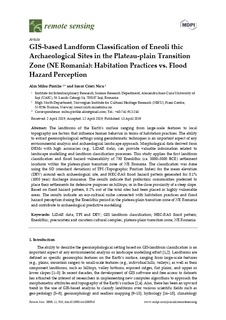| dc.contributor.author | Mihu-Pintilie, Alin | |
| dc.contributor.author | Nicu, Ionut Cristi | |
| dc.date.accessioned | 2019-10-15T11:58:01Z | |
| dc.date.available | 2019-10-15T11:58:01Z | |
| dc.date.created | 2019-06-03T15:39:07Z | |
| dc.date.issued | 2019-04 | |
| dc.identifier.citation | Remote Sensing. 2019, 11 (8), 915 | nb_NO |
| dc.identifier.issn | 2072-4292 | |
| dc.identifier.uri | http://hdl.handle.net/11250/2622252 | |
| dc.description.abstract | The landforms of the Earth’s surface ranging from large-scale features to local topography are factors that influence human behavior in terms of habitation practices. The ability to extract geomorphological settings using geoinformatic techniques is an important aspect of any environmental analysis and archaeological landscape approach. Morphological data derived from DEMs with high accuracies (e.g., LiDAR data), can provide valuable information related to landscape modelling and landform classification processes. This study applies the first landform classification and flood hazard vulnerability of 730 Eneolithic (ca. 5000–3500 BCE) settlement locations within the plateau-plain transition zone of NE Romania. The classification was done using the SD (standard deviation) of TPI (Topographic Position Index) for the mean elevation (DEV) around each archaeological site, and HEC-RAS flood hazard pattern generated for 0.1% (1000 year) discharge insurance. The results indicate that prehistoric communities preferred to place their settlements for defensive purposes on hilltops, or in the close proximity of a steep slope. Based on flood hazard pattern, 8.2% out of the total sites had been placed in highly vulnerable areas. The results indicate an eco-cultural niche connected with habitation practices and flood hazard perception during the Eneolithic period in the plateau-plain transition zone of NE Romania and contribute to archaeological predictive modelling. | nb_NO |
| dc.language.iso | eng | nb_NO |
| dc.publisher | MDPI | nb_NO |
| dc.rights | Navngivelse 4.0 Internasjonal | * |
| dc.rights.uri | http://creativecommons.org/licenses/by/4.0/deed.no | * |
| dc.subject | LiDAR data | nb_NO |
| dc.subject | TPI and DEV | nb_NO |
| dc.subject | GIS landform classification | nb_NO |
| dc.subject | HEC-RAS flood pattern | nb_NO |
| dc.subject | Eneolithic | nb_NO |
| dc.subject | precucuteni and cucuteni cultural complex | nb_NO |
| dc.subject | plateau-plain transition zone | nb_NO |
| dc.subject | NE Romania | nb_NO |
| dc.title | GIS-based Landform Classification of Eneolithic Archaeological Sites in the Plateau-plain Transition Zone (NE Romania): Habitation Practices vs. Flood Hazard Perception | nb_NO |
| dc.type | Journal article | nb_NO |
| dc.type | Peer reviewed | nb_NO |
| dc.description.version | publishedVersion | nb_NO |
| dc.rights.holder | © This is an open access article distributed under the Creative Commons Attribution License which permits unrestricted use, distribution, and reproduction in any medium, provided the original work is properly cited | nb_NO |
| dc.source.volume | 11 | nb_NO |
| dc.source.journal | Remote Sensing | nb_NO |
| dc.source.issue | 8 | nb_NO |
| dc.identifier.doi | 10.3390/rs11080915 | |
| dc.identifier.cristin | 1702384 | |
| cristin.unitcode | 7530,45,0,0 | |
| cristin.unitname | Nordområdeavdelingen | |
| cristin.ispublished | true | |
| cristin.fulltext | original | |
| cristin.qualitycode | 1 | |

